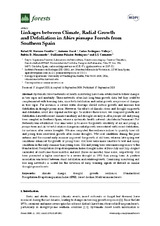Mostrar el registro sencillo del ítem
Linkages between Climate, Radial Growth and Defoliation in Abies pinsapo Forests from Southern Spain
| dc.contributor.author | Navarro Cerrillo, Rafael M. | |
| dc.contributor.author | Gazol, Antonio | |
| dc.contributor.author | Rodríguez-Vallejo, Carlos | |
| dc.contributor.author | Delgado Manzanedo, Rubén | |
| dc.contributor.author | Palacios Rodríguez, Guillermo | |
| dc.contributor.author | Camarero, J. Julio | |
| dc.date.accessioned | 2020-09-18T06:55:16Z | |
| dc.date.available | 2020-09-18T06:55:16Z | |
| dc.date.issued | 2020 | |
| dc.identifier.uri | http://hdl.handle.net/10396/20455 | |
| dc.description.abstract | Systematic forest networks of health monitoring have been established to follow changes in tree vigor and mortality. These networks often lack long-term growth data, but they could be complemented with tree ring data, since both defoliation and radial growth are proxies of changes in tree vigor. For instance, a severe water shortage should reduce growth and increase tree defoliation in drought-prone areas. However, the effects of climatic stress and drought on growth and defoliation could also depend on tree age. To address these issues, we compared growth and defoliation data with recent climate variability and drought severity in Abies pinsapo old and young trees sampled in Southern Spain, where a systematic health network (Andalucía Permanent Plot Network) was established. Our aims were: (i) to assess the growth sensitivity of old and young A. pinsapo trees and (ii) to test if relative changes in radial growth were related with recent defoliation, for instance, after severe droughts. We also computed the resilience indices to quantify how old and young trees recovered growth after recent droughts. Wet-cool conditions during the prior autumn and the current early summer improved the growth of old trees, whereas late-spring wet conditions enhanced the growth of young trees. Old trees were more sensitive to wet and sunny conditions in the early summer than young trees. Old and young trees were more responsive to the Standardized Precipitation-Evapotranspiration Index drought index of June–July and July–August calculated at short (one–three months) and mid (three–six months) time scales, respectively. Old trees presented a higher resistance to a severe drought in 1995 than young trees. A positive association was found between stand defoliation and relative growth. Combining monitoring and tree ring networks is useful for the detection of early warning signals of dieback in similar drought-prone forests. | es_ES |
| dc.format.mimetype | application/pdf | es_ES |
| dc.language.iso | eng | es_ES |
| dc.publisher | MDPI | es_ES |
| dc.rights | https://creativecommons.org/licenses/by/4.0/ | es_ES |
| dc.source | Forests 11(9), 1002 (2020) | es_ES |
| dc.subject | Climate change | es_ES |
| dc.subject | Drought | es_ES |
| dc.subject | Growth resilience | es_ES |
| dc.subject | Standardized Precipitation-Evapotranspiration Index (SPEI) | es_ES |
| dc.subject | Forest decline | es_ES |
| dc.subject | Mediterranean forests | es_ES |
| dc.title | Linkages between Climate, Radial Growth and Defoliation in Abies pinsapo Forests from Southern Spain | es_ES |
| dc.type | info:eu-repo/semantics/article | es_ES |
| dc.relation.publisherversion | https://doi.org/10.3390/f11091002 | es_ES |
| dc.relation.projectID | Gobierno de España. CGL2017-86161-R (ESPECTRAMED) | es_ES |
| dc.rights.accessRights | info:eu-repo/semantics/openAccess | es_ES |

